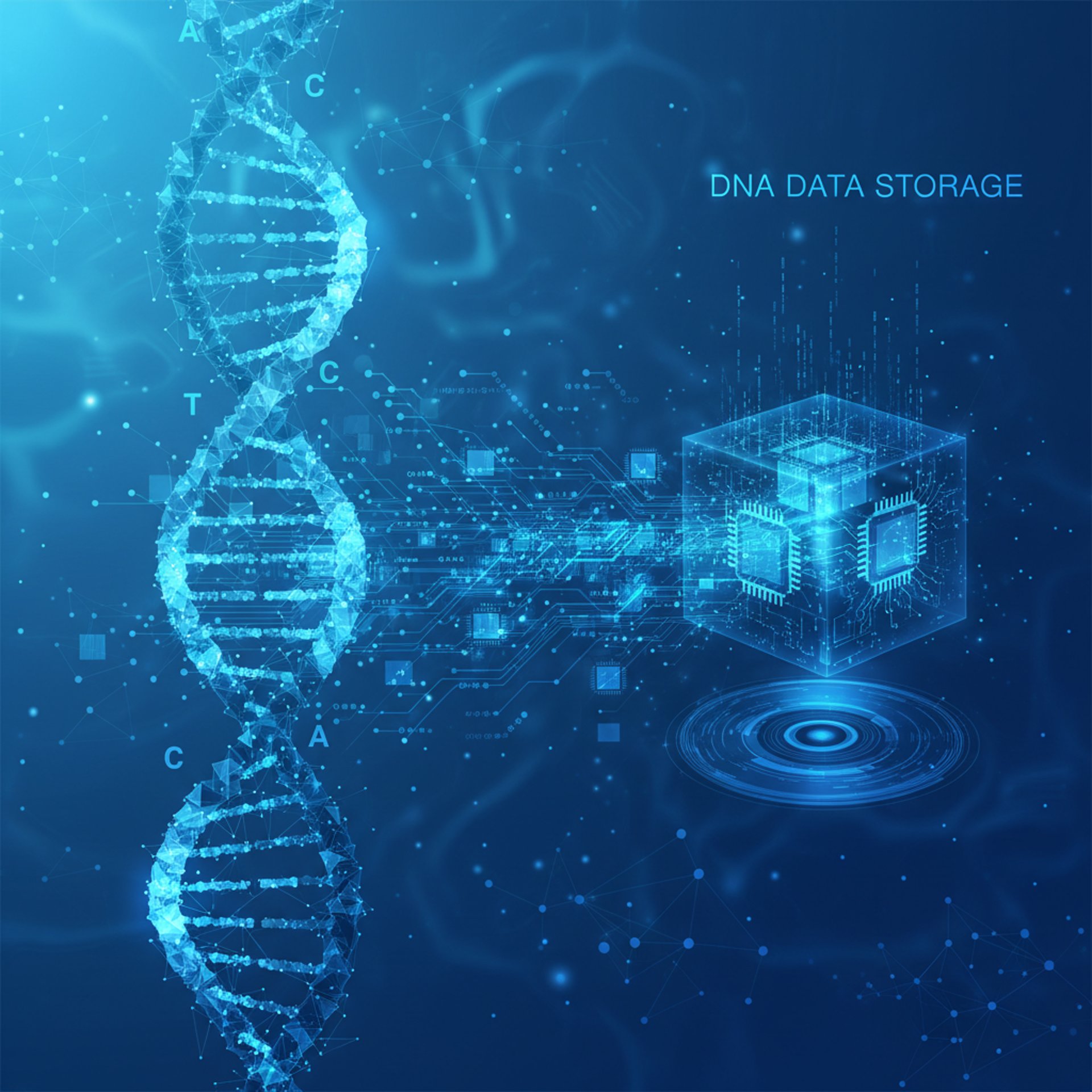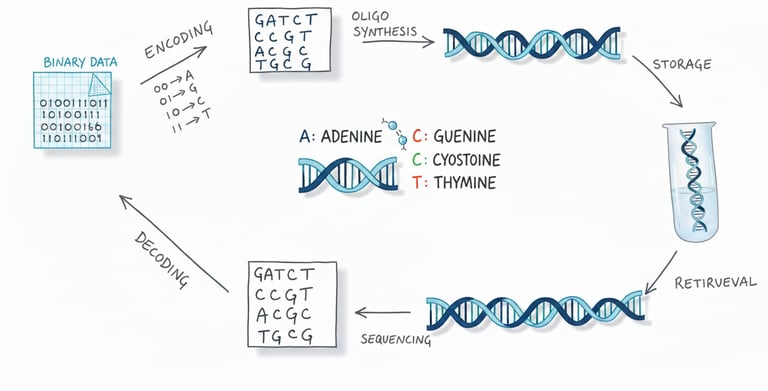
DNA Data Storage: Is it ready for prime time?
Recent research showcases an elegant solution to one of the key challenges in DNA data storage: how to efficiently address and retrieve thousands or millions of files embedded within DNA molecules. The answer lies in leveraging barcode patterns—familiar from packaging and logistics—written on a tape to enable efficient file location and content retrieval.
Shashi Adiga
10/3/20258 min read
As the total amount of digital data generated in the world (global datasphere) skyrockets—projected to reach 180 zettabytes by the end of 2025—the quest for durable, high-density, and sustainable storage solutions is more critical than ever. Traditional storage technologies—hard drives, magnetic tapes, and even cloud servers—are reaching their limits in terms of density, longevity, and sustainability. While they are more suitable for hot storage (fast, frequent, and immediate access to data) there is an unmet need in terms of archival, cold storage technology which is both economical and long lasting. A new frontier in data storage is emerging that combines molecular biology with advanced optical encoding—paving the way for ultra-high-density, durable storage solutions. DNA molecules, a proven means in biology for encoding, preserving, and transferring data over billions of years, are being explored for building a viable archival storage technology.
What is DNA data storage technology?
DNA, the blueprint of all living organisms, is a polymer/macromolecule made up of four chemical monomer units/bases: adenine (A), cytosine (C), guanine (G), and thymine (T). By translating binary data (0s and 1s) into sequences of these bases, one can “write” information into synthetic DNA strands. These strands can then be read back using DNA sequencing technologies, effectively retrieving the stored data. There are 4 DNA bases and together they can represent 4 values (A = 00, C = 01, G = 10, T = 11), and hence each base can encode 2 bits. In contrast, in solid-state drives (SSDs), the silicon-transistor-based memory cell works on the basis of voltage levels to store bits with each level encoded a as a bit (for example, single-level cells have a storage capacity of one bit per cell).


Figure 1. Key steps involved in DNA data storage
Advantages of DNA data storage
Unmatched Density: DNA’s molecular structure allows for incredibly dense data storage. In theory, a single gram of DNA could hold up to 215 petabytes (215 million gigabytes) of information—far surpassing any current technology's data density. (https://www.science.org/content/article/dna-printing-press-could-quickly-store-mountains-data).
Longevity: DNA is remarkably stable. Under proper conditions, it can last for thousands of years, making it ideal for long-term archiving of important data, from scientific records to cultural heritage.
Sustainability: Unlike energy-hungry data centers, DNA storage requires minimal energy once the data is encoded. This could help reduce the environmental footprint of global data storage making it suitable for data archiving.


How HDD/SSD/DNA storage stack up against each other
Key Challenges: from concept to practical use
Despite its promise, DNA data storage faces several technical and economic hurdles:
Cost: Synthesizing and sequencing DNA is very expensive, though costs are dropping rapidly.
Speed: Writing and reading data in DNA is way slower than electronic methods.
Error Rates: DNA synthesis and sequencing can introduce errors, making reliable data retrieval a challenge.
Scalability: Moving from small-scale demonstrations to storing terabytes or petabytes of data requires robust, scalable solutions, specifically managing large number of files.
Recent breakthrough: Barcode patterned DNA tape for fast and precision file management
Recent research by Southern University of Science and Technology, China (https://www.science.org/doi/10.1126/sciadv.ady3406), showcases an elegant solution to one of the key challenges: how to efficiently address and retrieve thousands or millions of files embedded within DNA molecules. The answer lies in leveraging barcode patterns—familiar from packaging and logistics—to label and organize data partitions printed on a tape.
The work introduces a compact DNA cassette tape system which works like magnetic tape but stores data in DNA. It packs tons of data partitions—over half a million per 1000 meters—and supports fast access and multiple file operations in under an hour. The tape uses special protective coatings for long-term stability and lets you write, store, and retrieve data automatically. It’s a potential game-changer for cold or warm data storage with DNA's massive density and longevity.
What are the key steps/processes involved in this technology?
Here is a list of the key steps and processes involved in the barcode pattern DNA tape-based data storage system :
Tape Preparation and Barcode Patterning:
Use laser inkjet printing to create barcode patterns (e.g., Code-128) along a polyester-nylon composite tape.
Generate physical partitions by printing black ink and cross-linked PDMS in the barcode regions, forming hydrophobic barriers.
Data Deposition (Writing Files):
Data encoding via the DNA fountain software and synthesize DNA oligomers
Deposit synthetic DNA in the hydrophilic “space” areas of the tape to represent data files.
Encode file information (folder names, file IDs) into barcode patterns for addressability.
Use microfluidic or mechanical systems (e.g., a rotating tape and simple “head”) to deposit DNA in specific regions efficiently.
File Addressing and Partitioning:
Generate addressable partitions via barcode codes.
Assign files to specific "spaces" within barcode regions, facilitating precise location and retrieval.
Data Retrieval (Reading Files):
Locate the barcode and associated DNA partition with optical sensors and barcode readers.
Extract the DNA by soaking the targeted partition in NaOH to denature and release ssDNA.
Sequence the DNA to recover the stored data.
File Removal and Rewriting:
Use restriction enzyme cut sites within DNA sequences for precise file removal.
Deposit new DNA in the same or a different partition for rewriting or updating data.
Micro-Reaction and Functional Operations:
Perform enzymatic reactions (e.g., DNA removal, polymerization, encapsulation) within designated micro-reaction chambers on the tape.
Manipulate the solid-liquid interface to enable functions like file encapsulation or decapsulation.
Automation and System Integration:
Use motorized tape movement, simple mechanical heads, and optical sensors for fully automated operation.
Allow for continuous, rapid deposition, retrieval, and editing of files within a compact device.
How does the writing system work?
Data is written onto the DNA tape by depositing synthetic DNA into the designated "space" regions of the barcode patterns. The process involves laser printing barcode patterns (hydrophobic black stripes separated by hydrophilic white spaces) on the tape and then depositing DNA sequences in the white areas within each partition. Although DNA synthesis is involved in creating the initial DNA sequences, the system is designed to support "write" operations without synthesizing new DNA for every update. Instead, the approach allows for DNA file deposition in specific partitions and can perform multiple write and rewrite cycles via biochemical processes such as DNA removal and redeposition. For long-term or large-scale storage, this minimizes the need for continuous DNA synthesis, making data writing more efficient. Essentially, the system can update or replace files through biochemical manipulations instead of synthesizing new DNA every time.
How does this method offer speed?
The DNA cassette's addressing system achieves rapid identification and access through a barcode-based two-level strategy. Each DNA tape is printed with continuous barcode patterns using laser inkjet technology, creating numerous addressable partitions (up to 5.45 × 10^5 per 1000 meters). The primary addressing involves recognizing the barcode to locate the general area of the target file, which is done at high speed (up to 1570 partitions per second). The secondary addressing then precisely identifies the specific file within that partition by scanning the barcode, which can be completed within 2 seconds. Additionally, the system employs a barcode reader based on a CMOS image sensor, capable of recognizing barcodes at rotation speeds up to 2400 rpm, enabling a file addressing rate of 1570 files per second—about 10 times faster than QR code-based methods. In addition to cold data storage this strategy opens up the possibility of hot data storage as well.
Why this matters?
The implications of this breakthrough are profound:
Archiving: Museums, libraries, and governments could use DNA to preserve priceless information for centuries.
Big Data: Fields like genomics, climate science, and artificial intelligence generate massive datasets that could be efficiently stored in DNA.
Cultural Heritage: DNA storage could safeguard humanity’s collective knowledge against disasters or technological obsolescence.
What are the challenges before the barcode patterned DNA tape technology can be commercialized?
Despite the significant advancements presented by Li et al. in developing a DNA cassette tape storage system, several potential barriers could hinder its widespread commercial adoption:
1. Cost of Production and Implementation
Although the system reduces some manual processes, costs associated with high-quality DNA synthesis, barcode printing, and associated reagents remain high. Scaling up for commercial use will require further cost reductions.
The expenses related to DNA encapsulation, decapsulation, and sequencing can be substantial, especially for large data volumes.
2. Engineering and Scalability Challenges:
Transitioning from laboratory prototypes to robust, industrial-scale systems demands overcoming engineering challenges related to mass production, durability, and reliability of the tape system.
Ensuring consistent tape fabrication, barcode quality, and reaction fidelity at scale is complex.
3. Data Retrieval Speeds vs. Conventional Storage:
While the approach allows rapid addressing and recovery, the overall data transfer rates may still lag behind existing electronic storage media (e.g., SSDs, HDDs).
For real-time or near-real-time applications, further improvements in read/write speeds are necessary.
4. Long-Term Stability and Error Rates:
Although DNA has excellent long-term stability, storage conditions, DNA degradation, and potential sequencing errors could affect data integrity over multiple decades.
The need for error correction mechanisms adds complexity and may increase costs.
5. Integration with Existing Data Infrastructure:
Compatibility with current digital storage and processing systems requires developing interfaces and standards for file management, encryption, and data security.
Conclusion: The road ahead
DNA data storage is moving from science fiction to scientific reality. With ongoing research and innovations like the recent Science Advances paper, we are closer than ever to a future where DNA archives power the world’s data needs.
As costs fall and technology improves, DNA could become the ultimate solution for long-term, sustainable, and ultra-dense data storage. I wouldn't be surprised if one day DNA data storage is used for hot-storage also.
Frequently asked questions (FAQs)
Frequently Asked Questions (FAQ) about Barcode Pattern DNA Tape Data Storage
Q1: What is barcode pattern DNA tape data storage?
It is a novel data storage method that uses a specially patterned tape with barcode regions to precisely deposit, locate, and retrieve DNA-encoded files. The barcode patterns create physical partitions and addressable regions on the tape, allowing high-density and automated data management.
Q2: How does the barcode pattern help in data storage?
The barcode patterns serve dual purposes: they form physical barriers to organize data in separate partitions, and they encode address information, enabling accurate locating and manipulation of files via optical reading systems.
Q3: What materials are used in creating the DNA tape?
The tape is made of a polyester-nylon composite film, on which barcode patterns are printed with inkjet printing of black ink and PDMS to create hydrophobic barriers.
Q4: How are data files stored on the tape?
Synthetic DNA molecules, encoding digital data, are deposited within the hydrophilic “space” regions of the tape. Each file is associated with a unique barcode, providing precise addressability.
Q5: How are files retrieved from the tape?
The tape is passed under optical sensors and barcode readers to locate the file's position. The targeted partition is soaked in NaOH solution to denature the DNA, which is then sequenced to recover the data.
Q6: Can files be deleted or updated easily?
Yes. Files can be removed using restriction enzymes that cut specific sequences. New DNA can be deposited in the same partition to update or rewrite files, enabling efficient editing.
Q7: What advantages does this system offer over traditional storage?
It offers ultrahigh data density (potentially petabytes per kilometer), automated operation, rapid deposition and retrieval, and long-term stability due to biochemical encapsulation methods.
Q8: How scalable is this technology?
With barcode patterns, a 1 km tape can generate over 500,000 addressable data partitions. The system can be scaled further by enhancing barcode complexity or partitioning schemes.
Q9: Is the system fully automated?
The DNA tape storage system is designed to operate with high levels of automation, including motorized tape movement, optical file targeting, and microreactors for DNA deposition and removal. However, it is not yet completely fully automated. Certain preparation steps, such as DNA pool synthesis and barcode attachment, currently require manual intervention. Additionally, achieving higher speeds in DNA deposition may require customized hardware beyond existing commercial systems. Overall, the system is approaching full automation but still involves some manual processes at present
Q10: What future improvements are possible?
Increasing barcode complexity, integrating advanced optical recognition, using smarter microreactors, and developing higher-density encoding formats could further enhance storage capacity and access speed.
Your feedback
What do you think about DNA data storage? Could it change the way we preserve information? Share your thoughts on this or any topic/technical deep dive you wish to see in this space by sending an email!
Insights
Exploring materials science and technology without jargon.
Connect
Subscribe
admin@matterdecoded.com
© 2025. All rights reserved.
